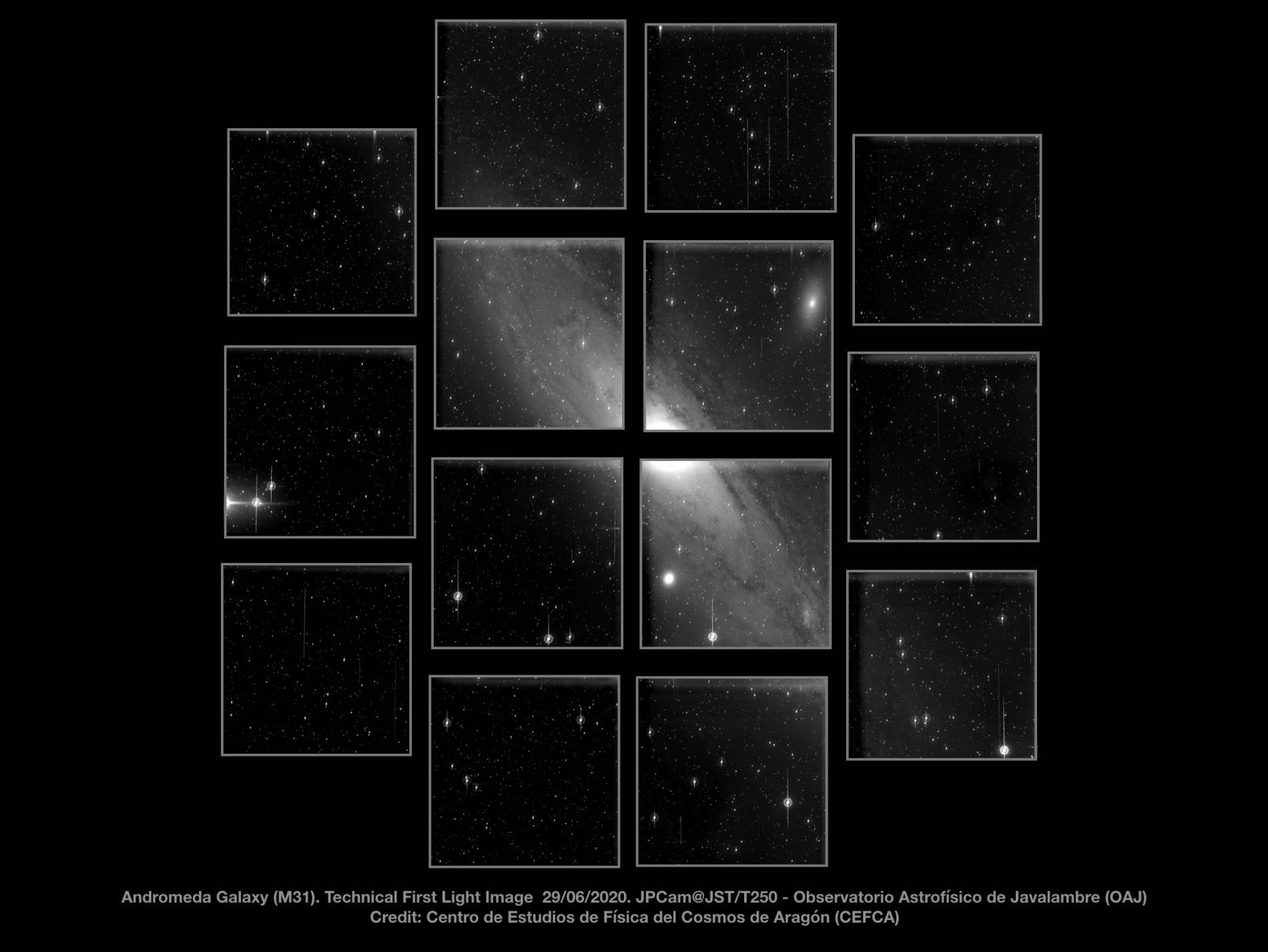
July 15, 2020
The entry into operation of the instrument represents the technological completion of the Javalambre Astrophysical Observatory in Teruel.
This instrument is key for J-PAS, an unprecedented future extragalactic mapping led by an international consortium that includes several researchers from the Institute of Physics of Cantabria.
JPCam, installed last June at the Cassegrain focus of the 2.5m Javalambre Survey Telescope (JST/T250) of the Javalambre Astrophysical Observatory (OAJ), successfully achieved technical first light on the night of June 29, obtaining for the first time images of the sky. With this milestone, the OAJ completes the first-generation instrumentation defined to carry out its scientific activity in the coming years.
In the field of professional astrophysics, the technical "first light" of a telescope or astronomical instrument is achieved when, for the first time, photons from stars or galaxies are collected and recorded by the detectors. The technical first light aims at verifying the fulfilment of the main technical performances of the system as specified in the design phase.
JPCam camera is the definitive scientific instrument of the OAJ JST/T250 telescope, designed to perform large sky surveys. JPCam is the second largest astronomical camera in the world, with more than 1,200 million pixels distributed in a mosaic of 14 scientific detectors that work in high vacuum conditions and at -110 degrees Celsius. Weighting over 1.5 tons, it provides scientific image quality with high resolution across the wide field of view. So much so, that to view one of its full-scale images it would be necessary to gather up to 570 Full HD monitors.
Such characteristics, together with a set of 56 filters covering the entire optical range of the spectrum, make JPCam one of the most powerful astronomical cameras in the world, specifically designed to perform large mapping of the sky, as J-PAS (Javalambre Physics of the Accelerating Universe Astrophysical Survey), a three-dimensional map of the Northern Hemisphere sky that will cover an area of 8. 500 square degrees and will generate 2.5 petabytes of scientific data with hundreds of millions of galaxies, and to which JPCam will dedicate most of its observation time.
"J-PAS will allow a 3D view of the Universe as it will be able to estimate the distance of each galaxy with good accuracy. Also, thanks to the large number of narrow filters (54), J-PAS will be able to separate objects that are projected along the line of sight and identify, for example, new gravitational lenses that would be impossible to detect with traditional techniques" says José María Diego, a researcher at Instituto de Física de Cantabria who is participating in the project.
JPCam has been designed by CEFCA and members of the J-PAS project (http://j-pas.org), a scientific collaboration led by CEFCA and the Spanish National Research Council through the Instituto de Astrofísica de Andalucía (IAA-CSIC) and researchers from IFCA (CSIC-UC), together with Brazilian institutions of the National Observatory of Rio de Janeiro and the University of Sao Paulo.
In addition to J-PAS, at least 20% of the time will be offered to the international scientific community, as part of the open time offered by the OAJ as ICTS so that researchers can access the use of their infrastructures through regular calls for competitive observation time. The data collected by JPCam will be of great importance for different fields of Astrophysics. J-PAS will allow to study questions such as the nature of dark energy or the history of the expansion of the Universe throughout the last 10.8 billion years, as well as the formation and evolution of galaxies, the structure and history of our Galaxy, the Milky Way , or the systematic study of asteroids in our Solar System.
The investment made in JPCam has exceeded 10 million euros, mainly from the Teruel Investment Fund, FEDER funds and the aforementioned Brazilian institutions.
With the first JPCam technical light, the phase of commissioning the camera in the telescope begins, during which the last work of fine-tuning and adjustment of this instrument in the JST/T250 will be carried out. In the next months, the team of scientists and engineers of CEFCA will carry out a set of verifications, adjustments and optimization of different systems of JPCam, of the telescope and of infrastructure of management and analysis of data with the aim of reaching their optimal performances. "The success of this phase is fundamental to guarantee the maximum scientific return of JPCam, of the JST/T250 and of the OAJ itself", explains Dr. Antonio Marín-Franch, researcher at the Centro de Estudios de Física del Cosmos de Aragón (CEFCA), head of the OAJ and Project manager of JPCam.
About CEFCA y OAJ
Centro de Estudios de Física del Cosmos de Aragón (CEFCA) is a research centre founded in 2008 and located in Teruel, dependent on Department of Science, University and Knowledge Society of the Government of Aragon. The main lines of research of CEFCA, which is an Associated Unit of CSIC, are Cosmology and Galaxy Formation and Evolution. CEFCA's activities include development, operation and scientific exploitation of the Spanish Singular Scientific and Technical Infrastructure (ICTS) of Javalambre Astrophysical Observatory (OAJ), which is equipped with two telescopes, specially designed to carry out large mappings of the sky, that are unique in the world. In addition, CEFCA is leading the J-PAS project, a multinational consortium that will carry out a map of Universe observable from Javalambre that is unprecedented in international astrophysics.
CEFCA website
About ICTS
The Singular Scientific and Technical Infrastructures (ICTS) are large facilities, resources, equipment and services, unique in their kind, which are dedicated to cutting-edge, top-quality research and technological development, as well as to promoting the transmission, exchange and preservation of knowledge, technology transfer and innovation.
The ICTS are unique or exceptional in their kind, and whose importance and strategic nature justifies their availability to the entire R+D+i collective. ICTS have three fundamental characteristics: they are publicly owned infrastructures, they are unique and open to competitive access.
ICTS website
More information:
https://www.cefca.es/noticias/mostrar/index/196
